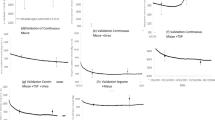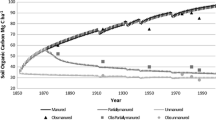Abstract
‘Soil Changes Under Agroforestry’ (SCUAF), a computer model designed to predict changes in erosion, soil carbon and soil nitrogen over time within various agroforestry systems and climatic regimes, was assessed using input data from an undisturbed miombo woodland and an adjacent maize field in Zimbabwe. Predicted changes in soil carbon were in a realistic range for both miombo and maize treatments. However, the accuracy of the model may be a reflection of the detail required in its initialisation. Several problematic relationships were found within the model, in particular inconsistent patterns between nitrogen uptake and plant productivity under complex fertilisation simulations and a lack of attenuation of productivity in the simulation of miombo woodland as it approached maturity.
Similar content being viewed by others
References
Ashworth VA (1990) Agricultural technology and the communal farm sector. Background paper for the World Bank Zimbabwean Agricultural Sector Memorandum. World Bank, Washington DC
Campbell BM, Swift MJ, Hatton J and Frost PGH (1988) Small-scale vegetation pattern and nutrient cycling in miombo woodland. In: Verhoeven JTA, Heil GW and Werger MJA, eds, Vegetation Structure in Relation to Carbon and Nutrient Economy, pp 69–85. SPB Academic Publishing, The Hague
Campbell BM, Vermeulen SJ and Lynam T (1991) Value of Trees in the Small-Scale Farming Sector of Zimbabwe. IDRC-MR302e. IDRC, Ottawa, 72 pp
Frost PGH (1985) Organic matter and nutrient dynamics in a broadleafed African savanna. In: Tothill JC and Mott JJ, eds, Ecology and Management of the World's Savannas, pp 200–206. Australian Academy of Science, Canberra
IBSNAT (1990) Network Report: 1987–1990. Department of Agronomy and Soil Science, College of Tropical Agriculture and Human Resources, University of Hawaii, Honolulu, HI, USA
Jones JW, Boote KS, Hoogenboom G, Jagtap S and Wilkerson G (1989) SOYGRO V5.42: Soybean Crop Growth Simulation Model: User's Guide. Florida Experimental Station Journal No. 8304. Agricultural Engineering and Agronomy Department, University of Florida, Gainsville, FL, USA
Johnson RWM (1962) Fertiliser response on maize under reserve conditions. Rhodesia Agricultural Journal 59: 222–223
King J and Campbell BM (1993) Soil organic matter under miombo woodland, plantations and crops. Forest Ecology and Management (in press)
Lamotte M and Boulière F (1983) Energy flow and nutrient cycling in tropical savannas. In: Boulière F, ed, Tropical Savannas, pp 583–603. Elsevier, Amsterdam
Muller MJ (1982) Selected Climatic Data for a Global Set Standard Stations for Vegetation Science. W Junk, The Hague, 306 pp
Parton, WJ, Schimel DS, Cole CV and Ojima DS (1987) Analysis of factors controlling soil organic matter levels in Great Plains grasslands. Soil Science Society of America Journal 51: 1173–1179
Parton WJ, Sanford RL, Sanchez PA and Stewart JWB (1989) Modeling Soil Organic Matter Dynamics in Tropical Soils. In: Coleman DC, Oades JM and Uehara G, eds, Dynamics of Soil Organic Matter in Tropical Ecosystems, pp 153–171. NifTAL Project, Paia, Hawaii
White F (1983) The Vegetation of Africa. UNESCO, Paris, 356 pp
Young A and Muraya P (1990a) Soil changes under agroforestry (SCUAF): a predictive model. ICRAF Reprint No. 74. ICRAF, Nairobi
Young A and Muraya P (1990b) SCUAF: Soil Changes under Agroforestry: a Predictive Model. Version 2. Computer Programme with User's Handbook. ICRAF, Nairobi
Author information
Authors and Affiliations
Rights and permissions
About this article
Cite this article
Vermeulen, S.J., Woomer, P., Campbell, B.M. et al. Use of the SCUAF model to simulate natural miombo woodland and maize monoculture ecosystems in Zimbabwe. Agroforest Syst 22, 259–271 (1993). https://doi.org/10.1007/BF00705238
Issue Date:
DOI: https://doi.org/10.1007/BF00705238




